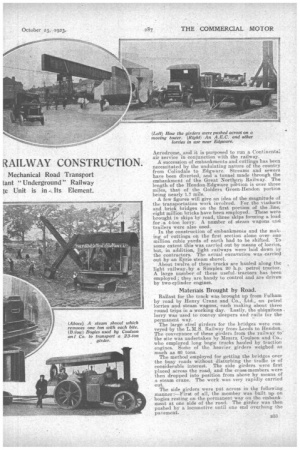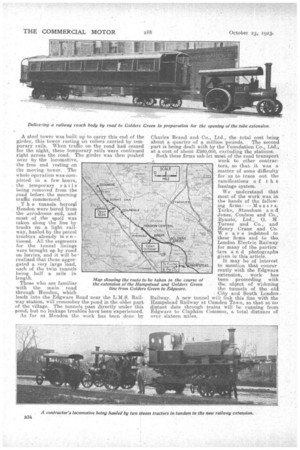THE MOTOR LORRY'S PAI RAILWAY CONSTRUCTION.
Page 14

Page 15

Page 16

If you've noticed an error in this article please click here to report it so we can fix it.
An Account of the Many Wa is Assisting in the Building c Extension. Where the HE Mechanical Road Transport tant " Underground " Railway Unit is in Its Element.
MHE new extension of the well-known Hampstead
Tube Railway, which links Golders Green to Edgware, has only been under construction since June, 1922. The first portion of the line, so far as Hendon, will be opened in a few weeks, and the remainder will be finished by the beginning o next year, so that it will be seen that extraordinarily rapid progress has been made.
It is not too much to say that the rapidity with which the work has progressed is largely due to the assistance rendered by all forms of road transport in conveying materials to the site. Spoil from the cuttings and tunneLs had to be conveyed considerable distances by road to form embankments on other portions of the line ; ballast had to be brought to the site from the other side of London ; steel girders had to be transported from the goods stations of the L.S.M. Railway and other equally difficult tasks performed.
For the benefit of those not acquainted with the country traversed by the new railway, the following description Of the route is given and a map is reproduced. Starting from Golders Green, a steel bridge carries the track over the Finchley Road, whence it passes over a brick viaduct to the Golders Green Road. Here another steel bridge has been built.
Cuttings, Viaducts, and Tunnels.
. Shortly after leaving this road the line passes through a cutting ahd under several by-roads, until Brent Station is reached. Here a lengthy embankment leads to the brick-built Brent Viaduct-600 ft. in length—which spans the valley of the Brent stream. A cutting then takes the line through the recreation ground to Hendon Central Station.
An enormous quantity of earth has been transported to the site of this station, in order. to form a level " circus " 240 ft. in diameter, the level of the ground having been raised by an amount of 12 ft.
The line then plunges into twin tunnels, half a mile in length, and emerges at the far side of the main line of the L.M.S. Railway near the Aerodrome.
At this point the roof of the tunnel is only a few feet beneath the Midland railway track; so that great care had to be exercised by the engineers. The main line was shored up with massive steel girders before any of the tunnelling was carried out. The tunnels are lined with exceptionally strong cast-iron Begments, which are encased in a thick bed of concrete, at this point. During these operations the mainline trains had to conform to a 10 m.p.h. speed limit at this spot.
It is +estimated that g0,000 tons of earth, removed from the tunnels, had to be conveyed to form the embankment farther on—near Colindale Station. This station is situated at the edge of the Hendon B32 Aerodrome, and it is purposed to run a Continental air service in conjunction With the railway. A succession of embankments and cuttings has been necessitated by the undulating nature of the country from Colindale to Edgware. Streams and sewers have been diverted, and a tunnel made through the embankment of the Great Northern Railway. The length5 of the Hendon-Edgware pOrtion is over three miles, that of the Golders Green-Hendon portion being nearly 1.7 mile. A few figures will give an idea of the magnitude of the transportation work involved. For the viaducts and .brick bridges on the first portion of the ,line, eight million bricks have been employed. These were brought in skips•by road, three skips forming a load for ,a 4-ton lorry. A number of steam wagons and trailers were also used.
In the construction of embankments and the making. of 'cuttings on the first section alone over one million cubic yards of earth had to be shifted. To some extent this was carried out by means of lorries, but, in addition, light railways were laid down by the contractors. The actual excavation was carried out by an Eyrie steam shovel. About twelve of these trucks are hauled along the light railway, by a Simplex 20 h.p. petrol ti:actor. A. large 'number of these useful tractors has been employed ; they.are handy to control and are driven by two-cylinder engines.
Materials Brought by Road.
Ballast for the track was brought up from Fulham by road by Henry Crane and Co., Ltd., on petrol lorries and steam wagons; each making about three round trips in a working day. Lastly, the ubiquitous lorry was used to convey sleepers and rails for the permanent way.
The large steel girders for the bridges were conveyed by the L.M.S. Railway from Leeds to Hendon. The conveyance of these girders from the railway to'" the site was undertaken by Messrs. Coulson and Co., who employed long bogie trucks hauled by traction engines. Sorbe of the heavier girders weighed as much as 60 tons.
The method employed for getting the bridges over the busy roads without disturbing the traffic is of considerable interest. The side girders were first placed across the road, and the cross-members were then dropped into position from above by means of a steam crane. The work was very rapidly carried out.
The side girders were put across in the following manner:—First of all, the member was atilt up on bogies resting on the permanent way on the embankment at one side of the road. The girder was then pushed by a locomotive until one end overhung the pavement.
A steel tower was built up to carry this end of the girder, this tower., resting on rollers carried by tem porary rails. When traffic on the road had ceased for the night, these temporary rails were continued right across the road. The girder was then pushed over by the locomotive, the free end resting on the moving -tower. The whale operation was corn, pleted in a few hours, the temporary rails being removed from the road before the morning traffic commenced.
T h e tunnels beyonsi Hendon were bored from the aerodrome end, and most' of the spoil was taken, along the line by trucks on a light rail. way, hauled by the petrol tractors already in e 111 tioned. All the segments for the tunnel linings were brought up by road on lorries, and it will be realized that these aggregated a very large load, each of the twin tunnels being half a mile in length. Map showing the route to Those who are familiar the extension of the Hemp r'71.1 '1\ 4 5.0r.ii1V4,0E
3U ON I OAK
Ir‘S -1p
COL1NDALE 1924 't
with the main road line from Golders
through 'Tendon, which leads into the Edgware Road near the L.M.S. Railway statidn, will remember the pond in the older part of the village. The tunnels pass directly under this pond, but no leakage troubles have been experienced. As far as Hendon the work has been done by
Charles Brand and Co., Ltd., the total cost being about a quarter of a million pounds. The second part is being dealt with by the Foundation Co.., Ltd:, at a cost of about £260,000, excluding the stations.
Both these firms sub-let most of the road transport work to other contrac tors, so that, it was a matter of some difficulty for us to trace out the ramifications of the 'haulage system.
We understand that most of the work was in the hands of the following firms :—Messr sYorke, Stoneham and Jones, Coulson and Co.,' Byauto; Ltd. 0.. H Turner and 'Co., and Henry Crane and Ca
VT are indebted to these firms and to the, London Electric Railway for many of the particu gars a a d photographs given in this article.
It may be of interest to mention that concur rently with the Edgware extension, work has been proceeding with the object of widening the tunnels of the old City and South London Railway_ A new tunnel will link this line with the Hampstead Railway at Camden Town, so that at no distant date through trains will be running from Edgware to Clapham Common, a total distance of over sixteen miles.






























